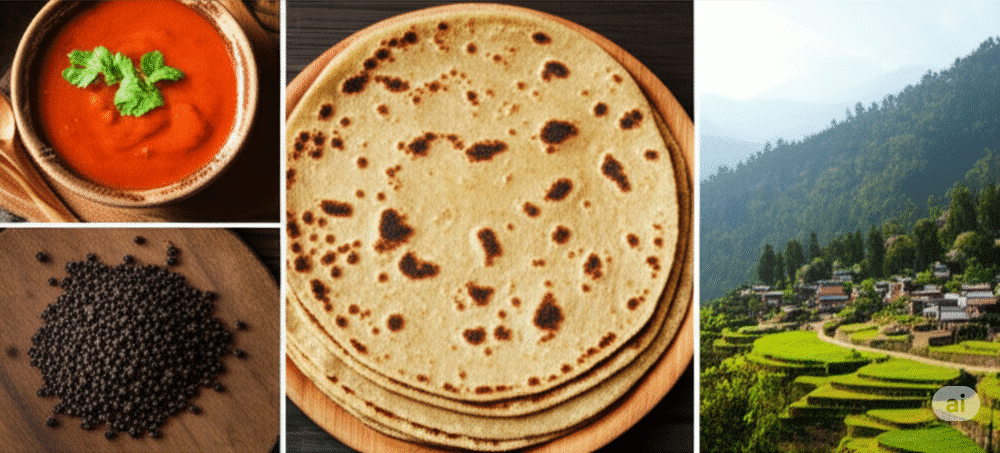Flavours of the Himalayas: A Soulful Journey Through Uttarakhand’s Wholesome Cuisine
Nestled in the pristine lap of the majestic Himalayas, the Indian state of Uttarakhand, divided into the distinct cultural and geographical regions of Kumaon and Garhwal, offers not just breathtaking landscapes but also a culinary heritage that is deeply rooted in simplicity, nutrition, and soulful sustenance. Unlike the often rich and complex gravies found in other Indian cuisines, Uttarakhandi food celebrates the purity of locally sourced ingredients, emphasizing wholesome sustenance over elaborate preparations. This guide invites you to explore the heartwarming traditions and unique flavours that define the ‘Devbhoomi’s’ cuisine.
The food of Uttarakhand is a testament to the resilient spirit of its people and the demands of its mountainous terrain. Dishes are typically prepared with minimal oil and spices, allowing the natural essence of the ingredients to shine through. Traditional cooking often involves slow methods, frequently in iron vessels (like a kadhai), which is believed to enhance both flavor and nutritional value. The result is a cuisine that is not only delicious but also remarkably healthy, perfectly suited to the cool mountain climate and the active lifestyle of its inhabitants.
Explore the Cuisine
The culinary traditions of Uttarakhand are broadly divided into Kumaoni and Garhwali cuisines, each with its unique characteristics shaped by local produce and cultural nuances. While both emphasize simplicity and nutrition, subtle differences in preparation and staple ingredients define their distinct identities.
Filter by Course: All Courses (Main Dishes, Staples, Sweets, Sides & Snacks)
Filter by Key Ingredient: All Ingredients (Lentils, Potato, Leafy Greens, Rice & Grains, Other)
Let’s embark on a flavorful journey through some of Uttarakhand’s iconic dishes:
Kafuli (Greens, Main)
A culinary gem of Uttarakhand, Kafuli is a thick, dark green gravy primarily made from spinach (palak) and fenugreek leaves (methi). These leafy greens are finely chopped or pureed and slow-cooked, traditionally in an iron kadhai, which imparts a distinctive earthy flavour and a rich hue. It’s often seasoned with minimal spices and best served with hot, steaming rice, often accompanied by a dollop of ghee, offering a comforting and wholesome meal.
Phaanu (Lentils, Main)
Phaanu is a comforting and soupy lentil dish, a staple in many Garhwali and Kumaoni households. It is typically prepared from various dals such as Gahat (Horse Gram), Arhar (Pigeon Pea), or green moong. The unique preparation involves soaking the dal overnight, then grinding it into a coarse paste before slowly cooking it to a soupy consistency. This method allows the lentils to release their full flavor and nutrients, making it a high-protein, nourishing dish, often consumed with plain steamed rice.
Baadi (Rice/Grains, Staple)
Simple yet profoundly nutritious, Baadi is a quintessential staple food of Uttarakhand, especially favored for its sustained energy release. It is made from Kwada ka Aata (Buckwheat flour). This dark-colored, dough-like preparation has a mild, sweet-sour taste. Baadi is often served with a generous dollop of ghee and is considered a perfect accompaniment to soupy dishes like Phaanu. Buckwheat, being gluten-free, offers a beneficial alternative for those with gluten sensitivities.
Aloo Ke Gutke (Potato, Side)
A simple yet incredibly appetizing Kumaoni dish, Aloo Ke Gutke perfectly showcases the region’s ability to create flavorful meals from basic ingredients. It involves boiling potatoes, cutting them into chunky pieces, and then stir-frying them with a minimal but impactful set of spices, typically including jakhya (wild mustard seeds), cumin, green chilies, and turmeric, often tempered in mustard oil. It’s a popular snack, especially during tea time, and can also be served as a delightful side dish with puris (fried bread) and local chutneys.
Chainsoo (Lentils, Main)
A very famous Garhwali dish, Chainsoo exemplifies the hearty and protein-rich nature of the cuisine. It is made from Urad Dal (black gram or Vigna mungo). The distinctive preparation involves dry roasting the dal until it turns golden brown and emits a nutty aroma, then grinding it into a coarse powder. This roasted powder is then slow-cooked in an iron pot with aromatic tempering, which deepens its flavor and gives it a unique smoky character. Known for its high protein content, Chainsoo is a highly nutritious and fulfilling dish, typically enjoyed with hot rice.
Rus/Thhatwani (Lentils, Main)
Rus, also known as Thhatwani, is another popular and light lentil preparation, primarily from Garhwal, though also common in Kumaon. This dish focuses on extracting the maximum flavor and nutrients from a mixture of lentils (like Bhatt, Gahat, Rajma, Lobia) in a soupy form. The lentils are boiled, and then a flavorful, thin stock or essence is carefully strained and served, often thickened with rice flour. It’s often tempered with local herbs like Jambu and Gandherni and is primarily enjoyed as a warm, comforting soup with steamed rice.
Dubuk/Dubke (Lentils, Main)
A beloved Kumaoni delicacy, Dubuk, sometimes referred to as Dubke, is a unique lentil curry known for its smooth texture and distinctive taste. It is prepared from local dals such as Bhatt (black soybean) or Gahat (Horse Gram). The dal is ground into a fine, smooth paste before being cooked into a flavorful, aromatic curry. This careful preparation gives Dubuk its characteristic velvety consistency and rich flavor. It’s considered a comfort food and is best savored with a side of hot steamed rice.
Jhangore ki Kheer (Rice/Grains, Sweet)
A truly delicious and traditional sweet dish from Garhwal, Jhangore ki Kheer is a must-have dessert in Uttarakhand. It is made from Jhangora (Barnyard Millet). Cooked with milk, sugar, and often garnished with dry fruits, this kheer offers a rich, slightly grainy texture and a unique, nutty flavor. It’s a wholesome and comforting treat, particularly during festivals and special occasions. Barnyard millet is also known for being gluten-free and a good source of fiber.
Gulgula (Rice/Grains, Sweet)
Gulgulas are delightful, sweet fritters, often described as a type of fried doughnut, popular as a snack and celebratory treat across Uttarakhand. They are primarily made from wheat flour and jaggery, which imparts a rich, caramel-like sweetness and a moist texture. These soft, pillowy treats are deep-fried until golden brown, making them a popular local delight, especially during festivals and religious ceremonies. They are simple to prepare and offer comforting sweetness.
Arsa (Rice/Grains, Sweet)
Arsa is a deeply cherished traditional sweet from Uttarakhand, essential for special occasions, weddings, and festivals. Made primarily from rice flour and jaggery, Arsa are small, round, and slightly chewy fritters. The dough is carefully prepared and then fried to a golden perfection. Its unique taste and traditional significance make it a quintessential sweet from the region, symbolizing auspiciousness and celebration. This sweet is found by various names across India, including “Ariselu” in the South.
Singodi/Singori (Other, Sweet)
A unique and very popular Kumaoni sweet, Singodi (or Singori) stands out not just for its taste but also its presentation. It is made from creamy Khoya (condensed milk), which is sweetened and often flavored with cardamom. What makes Singodi truly special is how it is traditionally wrapped: in a fresh Maalu leaf, which imparts a distinct, delicate aroma and a subtle, earthy flavor to the sweet, making each bite a unique experience.
Aloo Tamatar ka Jhol (Potato, Main)
A quintessential comfort food, Aloo Tamatar ka Jhol is a simple yet incredibly soulful potato and tomato curry. True to Uttarakhandi cuisine, it is made with minimal spices (cumin, turmeric, chili powder) and often tempered with jakhya or cumin seeds. The dish has a soupy consistency, making it ideal for pairing with hot steamed rice or rotis. It’s a testament to how simple, fresh ingredients can create a profoundly comforting and satisfying meal, rich in carbohydrates and fiber.
Kandalee Ka Saag (Greens, Main)
This is perhaps one of the most unique and intriguing green vegetable dishes from Uttarakhand. Kandalee Ka Saag is made from the stinging nettle plant (locally known as Bichhu Ghas or ‘scorpion grass’). The leaves, when fresh, cause a stinging sensation. However, locals skillfully boil these leaves to neutralize the sting, transforming them into a highly nutritious and flavorful saag. Once boiled, they are cooked with local spices, resulting in a healthy and surprisingly delicious preparation, rich in magnesium and iron.
Garhwal ka Fannah (Other, Side)
An exotic and flavorful dish, especially popular in areas like Mussoorie, Garhwal ka Fannah is a type of steamed dumpling or momo that has become a staple in the region. While its exact origins might vary, it’s firmly entrenched in the local culinary landscape. It is sometimes mentioned as a preparation of horse gram (Kulith). These dumplings are typically served with a spicy, tangy dip, offering a delightful snack or side dish that showcases the diverse influences on local cuisine.
Bhang Ki Chutney (Other, Side)
A vibrant and incredibly tangy condiment, Bhang Ki Chutney is a quintessential accompaniment to almost every Pahadi (hill) meal. It is made from roasted hemp seeds (bhang), which are non-psychoactive and rich in nutrients like Omega-3 and Omega-6 fatty acids. The seeds are ground with local spices such as cumin, green chilies, and fresh coriander, then finished with a squeeze of lemon juice. This chutney offers a unique nutty, pungent, and zesty flavor that perfectly complements the otherwise mild dishes of the region.
Mandua ki Roti (Rice/Grains, Staple)
Mandua ki Roti is a highly nutritious flatbread, a fundamental staple in Uttarakhand, particularly in the colder months. It is made from Mandua (Finger Millet) flour, a hardy grain rich in calcium, iron, and fiber. These rotis are dense and have a distinct earthy flavor. Due to millet’s lack of gluten, they are slightly coarser than wheat rotis but offer immense health benefits. Mandua ki Roti is typically eaten hot with a generous dollop of ghee and paired with local dals or saags.
Star Ingredients of the Hills
The distinct flavors and nutritional profile of Uttarakhandi cuisine are largely owed to its unique indigenous ingredients:
- Bhatt & Gahat: These local lentils, specifically Bhatt (black soybean, Phaseolus vulgaris) and Gahat (Horse Gram or Kulath, Macrotyloma uniflorum), are powerhouses of protein. Bhatt is a rich source of iron and protein and forms the base of hearty dals like Chainsoo and Dubuk. Gahat is renowned for its medicinal properties, aiding digestion and often used for kidney-related issues, making it a highly valued legume in the region, particularly for its heat-producing properties beneficial in cold winters.
- Mandua: Also known as Finger Millet or Ragi, Mandua is a hardy and drought-resistant grain widely cultivated in the Himalayan foothills. It is a nutritional marvel, boasting significantly higher calcium content than milk (some sources suggest up to 3 times more calcium per 100g than milk) and ample dietary fiber. It forms the basis of nutritious rotis and is also used in sweets like Jhangore ki Kheer, providing sustained energy and vital minerals.
- Jakhya & Bhang: These two ingredients are crucial for imparting authentic Pahadi flavor. Jakhya (Cleome viscosa) is a wild mustard seed, tiny and dark, used primarily for tempering. When crackled in hot oil, it releases a unique, pungent crunch and a warm, nutty aroma that elevates simple potato dishes (Aloo Ke Gutke) and dals. Bhang (hemp) seeds, are the non-psychoactive seeds of the hemp plant (Cannabis sativa). When roasted and ground with other ingredients, they create incredibly tangy, nutty chutneys that are a quintessential part of the Uttarakhandi meal, known for their unique flavor and nutritional benefits (rich in essential fatty acids).
The cuisine of Uttarakhand is more than just food; it’s an experience rooted in simplicity, tradition, and the abundant bounty of the Himalayas. It reminds us that true flavor often lies in the freshest, purest ingredients and cooking methods that honor their essence. It’s a culinary journey that nourishes both body and soul.




